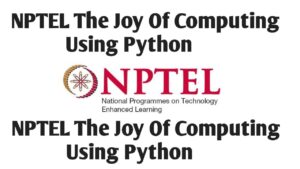Nptel The Joy of Computing Using Python Week 8 Assignment Answers
Searching for the Week 8 answers of the Nptel The Joy of Computing Using Python course? You’re in the right spot! Here, you’ll find reliable and up-to-date solutions to help you complete your Week 8 assignment with confidence.

The Joy of Computing using Python
ABOUT THE COURSE :
INTENDED AUDIENCE : Any interested audience
PREREQUISITES : 10th standard/high school
INDUSTRY SUPPORT : Every software company is aware of the potential of a first course in computer science. Especially of a first course in computing, done right.
COURSE LAYOUT – Click To Know More
- Motivation for Computing
- Welcome to Programming!!
- Variables and Expressions : Design your own calculator
- Loops and Conditionals : Hopscotch once again
- Lists, Tuples and Conditionals : Lets go on a trip
- Abstraction Everywhere : Apps in your phone
- Counting Candies : Crowd to the rescue
- Birthday Paradox : Find your twin
- Google Translate : Speak in any Language
- Currency Converter : Count your foreign trip expenses
- Monte Hall : 3 doors and a twist
- Sorting : Arrange the books
- Searching : Find in seconds
- Substitution Cipher : What’s the secret !!
- Sentiment Analysis : Analyse your Facebook data
- 20 questions game : I can read your mind
- Permutations : Jumbled Words
- Spot the similarities : Dobble game
- Count the words : Hundreds, Thousands or Millions.
- Rock, Paper and Scissor : Cheating not allowed !!
- Lie detector : No lies, only TRUTH
- Calculation of the Area : Don’t measure.
- Six degrees of separation : Meet your favourites
- Image Processing : Fun with images
- Tic tac toe : Let’s play
- Snakes and Ladders : Down the memory lane.
- Recursion : Tower of Hanoi
- Page Rank : How Google Works !!
Nptel The Joy of Computing Using Python Week 8 Assignment Answers
1) What will be the output of the following Python code?
tup = ([1, 2, 5], [3, 4])
tup[0].append(5)
print(tup)a) ([1, 2, 5], [3, 4])
b) ([1, 2], [3, 4])
c) ([1, 2], [3, 4, 5])
d) TypeError: Tuple object does not support item assignment
View Answer
2) What operations can be performed on tuples?
a) Tuples are appendable
b) We can delete a value from tuples
c) Both (a) and (b)
d) We can count the number of instances of an element
View Answer
3) What will be the output of the following Python code?
a) 1, 2, 3, 4, 5
b) 5, 4, 3, 2, 1
c) 5, 4, 3, 2
d) 1, 2, 3, 4
View Answer
4) What will be the output of the following Python code?
a) facebook
b) gbdfcppl
c) ezbdannj
d) ytvxuhhdView Answer
For Latest Update Join our official channel: Click here to join
5) When will the program print “Clap”?
a) When both players enter the same letters.
b) When player 2 enters the next letter after player 1.
c) When player 1 enters the next letter after player 2.
d) It will never clap.
View Answer
6) What will be the effect of the following Python code on the graph?
a) The graph will go up when guess and pick are the same.
b) The graph will go down when guess and pick are the same.
c) The graph will go up when guess and pick are not the same.
d) Both (b) and (c)
View Answer
7) What is the primary advantage of using tokenization in Natural Language Processing (NLP)?
a) It allows the model to understand entire sentences as a single entity.
b) It splits text into smaller, manageable units, which helps in processing language more effectively.
c) It eliminates the need for syntactical analysis.
d) It improves the grammatical structure of the text.
View Answer
8) What will be the output of the following Python code?
string = 'hey!there'
a = sorted(string)
a.reverse()
print(a)a) [‘!’, ‘e’, ‘e’, ‘e’, ‘h’, ‘h’, ‘r’, ‘t’, ‘y’]
b) [‘h’, ‘e’, ‘y’, ‘!’, ‘t’, ‘h’, ‘e’, ‘r’, ‘e’]
c) [‘y’, ‘t’, ‘r’, ‘h’, ‘h’, ‘e’, ‘e’, ‘e’, ‘!’]
d) None of the above
View Answer
For Latest Update Join our official channel: Click here to join
9) While converting an image into black and white, can it be converted back into a colored image?
a) True
b) False
View Answer
10) What will be the output of the following Python code?
a) Converting lowercase letters into uppercase
b) Converting uppercase letters into lowercase
c) Returns the same word.
d) Error.
View Answer
Nptel The Joy Of Computing Using Python Week 9 Assignment Answers – Click Here